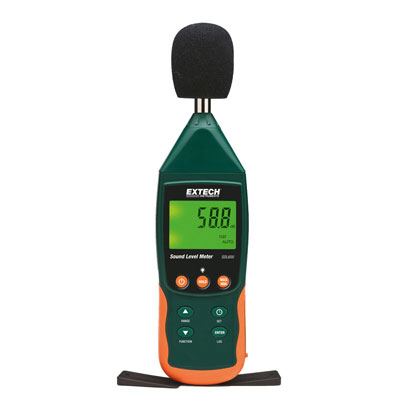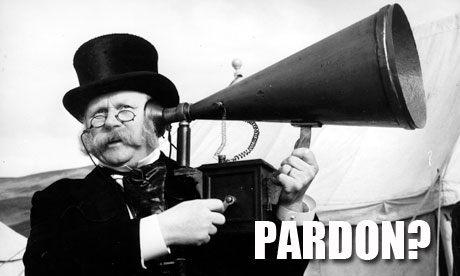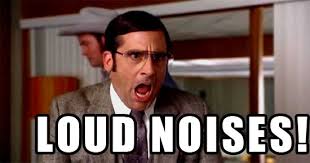Sound is, really, a thing we take for granted. It's all around us every day, whether it be something as simple as fingers tapping on a keyboard or the roar of a jet engine passing high overhead. Although we do take it for granted, testing sound levels, in many applications, is a necessary process designed to protect those around sounds from harm.
What Is Sound?
It may seem obvious - but sound isn't just 'that stuff you can hear'. Sound is defined as a type of energy, and it is energy that consists of pressure vibrations in the air around us. It's completely invisible to the naked eye, but these pressure vibrations are produced by practically everything as an object vibrates, creating pressure waves which cause what is known as recurring compression and rarefaction of the air around us.
Compression is an "area of increased pressure in a sound wave produced when a vibrating object moves outwards. Rarefaction is an area of reduced pressure in a sound wave produced when a vibrating object moves inward." (Test Instruments, P. 206) Both of these effects combine together to create the vibration in the air, and this vibration is picked up by the delicate bones in our ears in order to transform the vibration into discernible sound.
Sound is also given what's known as a frequency. This, in technical terms, is defined as the number of air pressure fluctuation cycles produced per second. Measures in hertz, Hz, frequency basically defines the tone of the sound heard. Higher frequency sounds (often not able to be discerned by human ears) are much shriller and higher than low frequency sounds, which are deeper and more bass-like. The basic rule for frequency is that the faster an object vibrates, the higher overall frequency it will produce. Lower, bass frequencies tend to vibrate at several hundred times a second, while higher frequencies vibrate in the thousands.
Sound intensity (also known as volume) is a measure of the overall amount of energy inside a sound wave. Amplitude is the distance that vibrating object moves from a position of rest during vibration. If amplitude is larger, this in turn causes a louder sound. This is as a result of the sound wave fluctuating much more in the air, and the eardrums pick up on this excessive fluctuation and register the sound as being loud - indeed it's possibly for exceptionally loud sounds to damage the eardrum significantly, and this is one of the most important reasons why carrying out sound measurements is of the utmost importance.
The universally accepted measurement used for testing sound is the decibel, or dB. Depending on the overall loudness of the sound the decibel level gradually rises - once it reaches a decibel level of 130dB, this is the point where sound becomes painful when heard by the human ear.
The following information gives you an idea of the different decibel levels and their effect on human ears.
Very Faint
- 0dB - Hearing Threshold
- 10dB - Whisper
Faint
- 20dB - Quiet Living Room
- 30dB - Quiet Conversation
Moderate
- 40dB - Running Refrigerator
- 50dB - Normal Conversation
Loud
- 70dB - Busy Street
- 80dB - Vacuum Cleaner
- Very Loud
- 90dB - Heavy Truck Traffic
- 100dB - Subway
- 110dB - Chainsaw
- 120dB - Thunder
- 130dB - Air Raid Siren (Pain Threshold)
Deafening
- 140dB - Loud Rock Music
- 150dB - Explosion
- 160dB - Jet Engine
- 180dB - Rocket Engine
As you can see, there's a massive difference in having a chat and standing next to a rocket engine. In fact, standing next to a rocket's engine is likely to severely damage your hearing, and protective measures must be taken whenever a sound is above 130dB in order to prevent a human's ears from being damaged. This is why workers in extremely loud industrial plants, such as powerstations, must wear protective earmuffs to block their exposure to extreme sound levels.
Note: OSHA (The Occupational Health and Safety Administration) actually lists that a time period of 30 minutes is all a human ear can handle at 110dB before some form of damage takes place. It also goes on to state that the human ear can handle two hours at 100dB or 4 hours at 95dB before the ear becomes permanently damaged.
Measuring Sound
In cases where there's a significant risk to human ears due to exposure of extreme sound, measuring the overall dB level of the sound in an environment is extremely important. It's also not uncommon to see testing being carried out in recording studios, factories, airports and even outdoor and, in order to test, you're going to need one of these:
[caption id="attachment_398" align="aligncenter" width="400" caption="Model Shown is the Extech SDL600"] [/caption]
[/caption]
This device is known as a sound level meter. Also commonly just called sound meters, these devices are able to measure the overall level of a noise, and display the result as a decibel reading on the front of the tester. Depending on the make and model of tester, the device may be able to continuously monitor sound over a time period, or is alternatively suitable for use as a single measurement.
Sound Meter Classes
Sound meters are generally classified into two different classes (or types). Class 1 instruments have wider frequency range and are thus much more adaptable to sound than class 2 devices are, making them much more efficient for measuring sound levels across a larger scope.
Class 1 devices are most likely to be used for precise sound measurements such as in a laboratory, and are commonly seen been used in environment, building acoustics and road vehicle evaluations. Class 2 devices are much more general use, and can be used for everything from simple noise measurement at work to carrying out basic environmental testing.
Choosing the right class of sound level meter is therefore quite important - if you need exact measurements on complex equipment or frequencies, class 1 is the way to go. If you just want a basic idea of sound, Class 2 is the way forward. Picking the right one, and the right sound meter can save you a lot of time and make sure you're in line with all rules and regulations governing sound.
Noise Regulations
Here in the UK, sound levels in the workplace are governed over by a directive known as The Control of Noise at Work Regulations 2005, which has been the official standard since 2006.
This directive is in place to ensure that worker's hearing is protected from excessive noise at their place or work, particularly when not doing so could cause a loss of hearing and/or to suffer from tinnitus (permanent ringing of the ears).
Under these regulations the employer is entirely responsible for protecting their worker's hearing; at 85dB they must provide hearing protection and hearing protection zones and at 80dB adequate training and information must be given to all affected employees.
You can view more information on the Control of Noise at Work by visiting the link.




